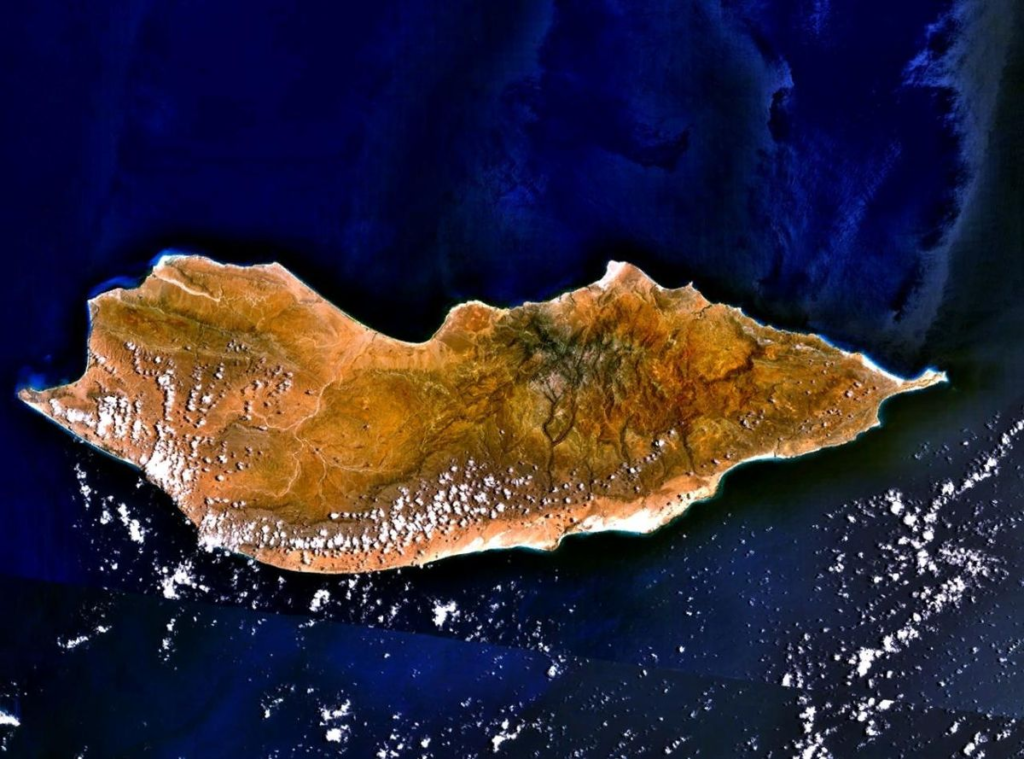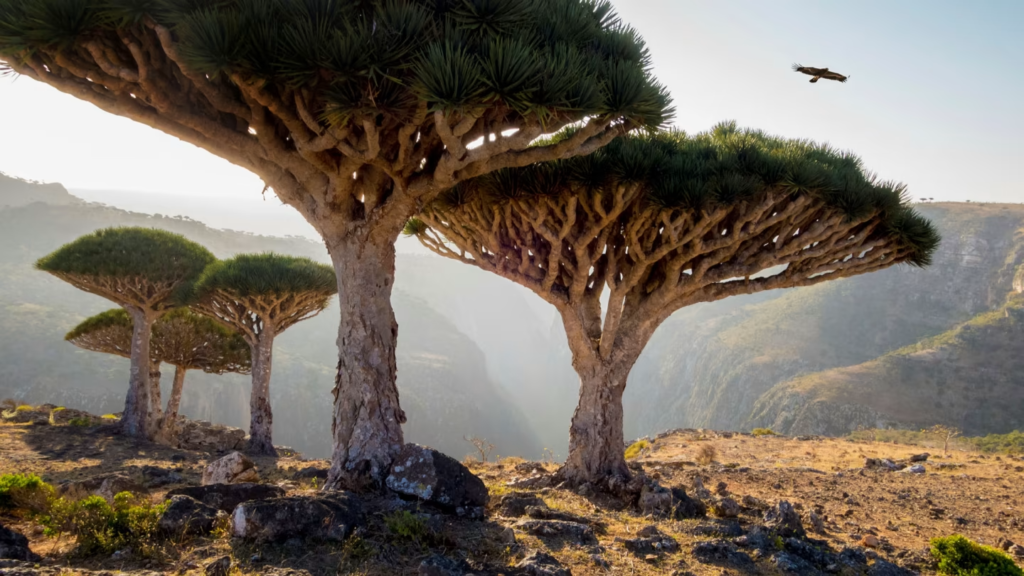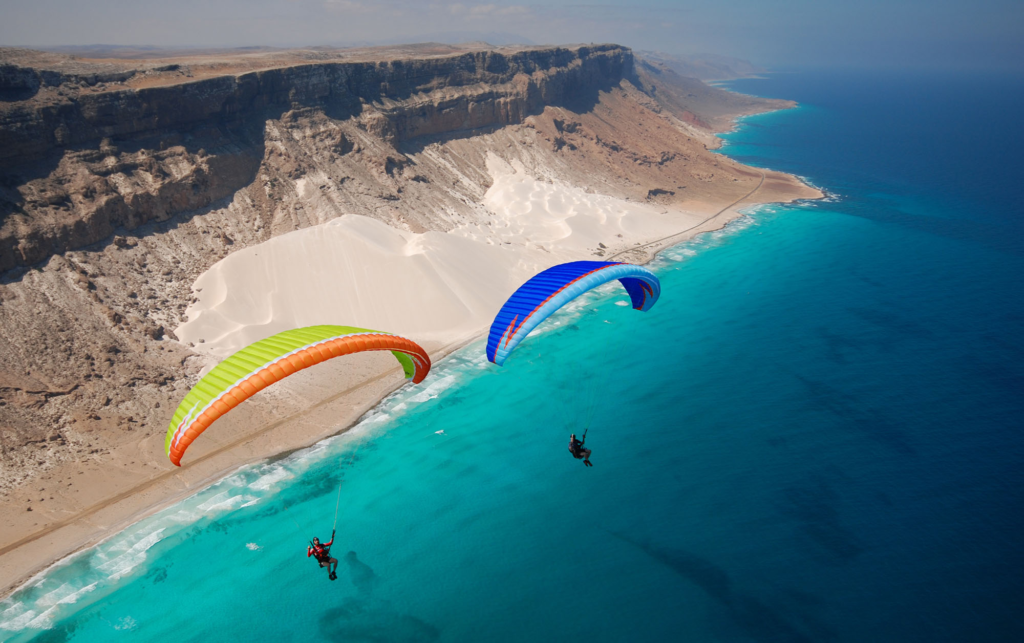Socotra Island, with its bizarre landscapes and alien-like biodiversity, feels as if it belongs not on Earth but on another planet. Off the coast of Yemen, in the azure waters of the Arabian Sea, lies a Socotra, This remote and isolated island, part of an archipelago, is a natural wonder, boasting species found nowhere else in the world and offering a glimpse into a prehistoric era untouched by time.
A Landscape from Another World

The first thing visitors to Socotra island is how dramatically different the island’s landscape is from anything else on Earth. Imagine a rugged terrain dominated by towering mountains, vast sand dunes, and white sandy beaches that stretch for miles. But it’s the unusual vegetation and rock formations that make Socotra seem truly extraterrestrial.
One of the most iconic features of Socotra is the Dragon’s Blood Tree (Dracaena cinnabari). This tree, with its umbrella-like canopy and thick, twisting branches, looks like something straight out of a science fiction movie. Its blood-red sap, from which it gets its name, was highly prized in ancient times for its medicinal properties and as a dye. These trees, found only on Socotra, are scattered across the island’s plateaus, giving the landscape an eerie, otherworldly quality.
Another fascinating plant species is the Desert Rose (Adenium obesum socotranum). Resembling a giant, swollen bottle with pink flowers sprouting from its top, it thrives in the harsh, arid climate of Socotra. Its bulbous trunk stores water, allowing it to survive in this desolate environment. These plants, coupled with the island’s jagged limestone cliffs and caves, create a landscape that feels like stepping onto another planet.
Endemic Wildlife: Life Found Nowhere Else

Socotra island isolation from the mainland for millions of years has allowed for the evolution of a unique ecosystem, much like the Galápagos Islands. Over a third of Socotra’s plant species are endemic, meaning they are found nowhere else on Earth. The island’s fauna is similarly extraordinary, with species that seem to have evolved in isolation from the rest of the planet.
The Socotra Starling, Socotra Sunbird, and Socotra Cormorant are among the many bird species that call the island home. Birdwatchers are often drawn to the island to catch a glimpse of these rare, native birds. The island also boasts reptiles like the Socotra Chameleon and unique invertebrates, such as the Socotran spiders, which have adapted to survive in its rugged environments.

Interestingly, Socotra island has no large mammals, and even human activity on the island has been relatively recent and minimal, which has allowed the natural world to thrive with little disturbance.
An Ancient Island with a Deep History
Though Socotra feels like another planet, its history is deeply tied to Earth’s ancient civilizations. The island was known to ancient mariners, traders, and explorers as early as the 1st century AD. Socotra was a key stop along the trade routes that connected Africa, the Middle East, and South Asia. It was famous for its Dragon’s Blood resin, which was highly valued by the Greeks, Romans, and other cultures.

Despite its long history of human contact, Socotra island has remained remarkably untouched by the modern world. Its remoteness has preserved its natural beauty, and its traditional way of life continues to thrive. The island’s people, known as the Soqotri, speak a distinct language, and their culture is closely tied to the land and sea that sustains them.
Socotra Island is A Fragile Paradise

While Socotra’s isolation has protected its unique environment for centuries, the island is increasingly under threat from climate change, development, and human activity. Rising temperatures, invasive species, and overgrazing by livestock are beginning to put pressure on its fragile ecosystems.
Recognizing its ecological importance, UNESCO declared Socotra a World Heritage Site in 2008. Conservation efforts have since focused on protecting the island’s unique flora and fauna while ensuring that the local population can continue to live sustainably on the island. Ecotourism has become a growing industry, providing income for the island’s inhabitants while raising awareness about the need to protect its environment.
Socotra Island: A Glimpse into a Lost World

Socotra Island is not just a place for adventure; it is a living museum of natural history, offering visitors a rare chance to see what the Earth might have looked like millions of years ago. Its strange landscapes, endemic species, and deep-rooted culture make it a destination like no other. For those fortunate enough to visit, Socotra offers a chance to step back in time—or perhaps into another world entirely.
As we look to the future and grapple with the challenges of climate change and biodiversity loss, Socotra stands as a reminder of the planet’s natural beauty and resilience. It is a place where the past, present, and future of life on Earth converge in a stunning display of evolution’s power. The wonder of Socotra lies not just in its alien-like appearance but in its ability to remind us of the incredible diversity and fragility of life on our planet.
Traveling to Socotra Island can be a bit of an adventure due to its remote location and limited accessibility, but for those who make the journey, it is an unforgettable experience. Here’s a guide on how to travel to Socotra:
1. Flights to Socotra Island

Reaching Socotra typically involves flying into mainland Yemen and then catching a local flight to the island. However, because of political instability and conflicts in Yemen, flights have often been disrupted. In recent years, some alternative routes have opened up:
- Flights from the UAE (Abu Dhabi): Direct charter flights are sometimes available from Abu Dhabi to Socotra. These flights are typically seasonal or organized by specialized tour operators. Always check with a reliable tour company for the latest availability.
- Flights from Cairo, Egypt: There are sometimes charter flights from Cairo to Socotra, also typically organized by tour groups.
Due to the complex situation in Yemen, you should book flights through a specialized travel agency that operates tours to Socotra, as they will be aware of the current routes and any restrictions in place.
2. Visas for Socotra

Most travelers will need a visa to visit Socotra. Given Yemen’s political situation, obtaining a visa can be tricky. Usually, the travel agency or tour operator handling your trip will assist you with the visa process. The visa is generally issued for Socotra Island, meaning you may not be able to visit other parts of Yemen.
3. Best Time to Visit Socotra
The best time to visit Socotra is between October and May, when the weather is mild, and the island’s unique flora is in full bloom. Avoid visiting during the monsoon season (June to September), as strong winds and storms can disrupt travel and make the island less accessible.
4. Tour Operators
Because of Socotra’s remote nature and the limited infrastructure for independent travelers, it is highly recommended to book your trip through a tour operator. These agencies usually handle everything, from flights and accommodation to permits and guided tours. Some reputable operators specialize in eco-tourism and adventure travel to Socotra, ensuring a smooth and safe journey.
5. Transport on Socotra

Once on the island, transportation options are limited. Most visitors travel by 4×4 vehicles, which are necessary for navigating the island’s rugged terrain. Tour companies generally provide transportation as part of their package, along with local guides who are familiar with Socotra’s unique landscapes and wildlife.
6. Hotels
Socotra’s infrastructure is minimal, and there are only a few hotels and guesthouses on the island, mainly in the capital, Hadibo. However, many visitors choose to stay in eco-camps or simple tented accommodations arranged by tour operators. This option allows you to experience the island’s remote beauty up close while minimizing your environmental footprint.
7. Essential Travel Tips
- Pack essentials: Socotra has limited facilities, so bring everything you need, including any medications, toiletries, and personal items.
- Prepare for basic amenities: Electricity and running water can be unreliable in some areas, so be prepared for a rustic experience.
- Respect the environment: Socotra is a UNESCO World Heritage site, home to unique flora and fauna. It’s crucial to follow eco-friendly practices and leave no trace during your visit.
Read more : 10 Things to Know About Traveling by Plane



